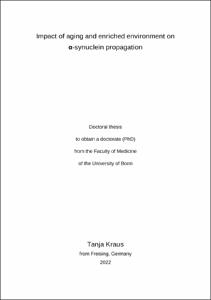Kraus, Tanja: Impact of aging and enriched environment on α-synuclein propagation. - Bonn, 2022. - Dissertation, Rheinische Friedrich-Wilhelms-Universität Bonn.
Online-Ausgabe in bonndoc: https://nbn-resolving.org/urn:nbn:de:hbz:5-66045
Online-Ausgabe in bonndoc: https://nbn-resolving.org/urn:nbn:de:hbz:5-66045
@phdthesis{handle:20.500.11811/9732,
urn: https://nbn-resolving.org/urn:nbn:de:hbz:5-66045,
author = {{Tanja Kraus}},
title = {Impact of aging and enriched environment on α-synuclein propagation},
school = {Rheinische Friedrich-Wilhelms-Universität Bonn},
year = 2022,
month = apr,
note = {Parkinson's disease (PD) is the second most common neurodegenerative disease. The prevalence of sporadic PD results from a complex interaction of demographic, genetic, and environmental factors. Age is one of the strongest risk factors, while on the other hand, physical activity is considered a protective factor. PD is characterized by three pathological hallmarks (i) α-synuclein-rich inclusions found in neurons known as Lewy bodies, (ii) loss of dopaminergic neurons in the Substantia nigra pars compacta, and (iii) chronic neuroinflammation. The α-synuclein depositions show a spatiotemporal distribution pattern in PD patients during disease progression suggesting that α-synuclein may propagate to distinct neuronal populations throughout the brain by neuronal connectivity.
However, it is unclear how aging as a cell-intrinsic factor and an enriched environment (EE) combining physical exercise and cognitive stimulation as an external factor influence α-synuclein pathology, microglia activation and neuronal vulnerability. To investigate how these factors may modulate the propagation of α-synuclein, we have chosen a PD mouse model with unilateral injection of recombinant adeno-associated viral vectors into the vagus nerve which leads to overexpression of human α-synuclein (ha-syn) in the neurons of its dorsal motor nucleus (DMX). This model shows selective spreading of the overexpressed ha-syn from the medulla oblongata to the pons, midbrain, and forebrain by neuron-to-neuron transmission. Our results show in the affected regions of ha-syn expression (DMX) and spreading (e.g. pons and midbrain) an increase in microglial activation with EE treatment compared to standard housed mice. However, EE does not influence the ha-syn propagation to more rostral brain regions. We demonstrate that aging accelerates the propagation of ha-syn, as mid-aged (13-15 months) and aged mice (22-23 months) showed increased accumulations in higher brain regions compared with young mice (3-5 months). Interestingly, this propagation was related to increased ha-syn levels in the DMX over time in mid-aged and aged mice. We showed that these higher levels resulted from inverse neuronal loss in the DMX, with young mice exhibiting more neuronal loss than older mice. This inverse age-dependent susceptibility in neurons of the DMX was also observed with GFP overexpression, indicating a general susceptibility to overexpression of toxic proteins. Moreover, these results might be related to the different number and activation of microglia in young and aged animals.
These findings suggest an inverse age-specific vulnerability of neurons in the DMX, which then specifically drives ha-syn propagation in aged animals in our ha-syn overexpression and propagation model. This may be an important process in PD that neurons with high levels of α-synuclein cannot be degraded and continue to propagate and accumulate α-synuclein to other brain regions. This is important as it is known that with aging neurons accumulate increased levels of α-synuclein.},
url = {https://hdl.handle.net/20.500.11811/9732}
}
urn: https://nbn-resolving.org/urn:nbn:de:hbz:5-66045,
author = {{Tanja Kraus}},
title = {Impact of aging and enriched environment on α-synuclein propagation},
school = {Rheinische Friedrich-Wilhelms-Universität Bonn},
year = 2022,
month = apr,
note = {Parkinson's disease (PD) is the second most common neurodegenerative disease. The prevalence of sporadic PD results from a complex interaction of demographic, genetic, and environmental factors. Age is one of the strongest risk factors, while on the other hand, physical activity is considered a protective factor. PD is characterized by three pathological hallmarks (i) α-synuclein-rich inclusions found in neurons known as Lewy bodies, (ii) loss of dopaminergic neurons in the Substantia nigra pars compacta, and (iii) chronic neuroinflammation. The α-synuclein depositions show a spatiotemporal distribution pattern in PD patients during disease progression suggesting that α-synuclein may propagate to distinct neuronal populations throughout the brain by neuronal connectivity.
However, it is unclear how aging as a cell-intrinsic factor and an enriched environment (EE) combining physical exercise and cognitive stimulation as an external factor influence α-synuclein pathology, microglia activation and neuronal vulnerability. To investigate how these factors may modulate the propagation of α-synuclein, we have chosen a PD mouse model with unilateral injection of recombinant adeno-associated viral vectors into the vagus nerve which leads to overexpression of human α-synuclein (ha-syn) in the neurons of its dorsal motor nucleus (DMX). This model shows selective spreading of the overexpressed ha-syn from the medulla oblongata to the pons, midbrain, and forebrain by neuron-to-neuron transmission. Our results show in the affected regions of ha-syn expression (DMX) and spreading (e.g. pons and midbrain) an increase in microglial activation with EE treatment compared to standard housed mice. However, EE does not influence the ha-syn propagation to more rostral brain regions. We demonstrate that aging accelerates the propagation of ha-syn, as mid-aged (13-15 months) and aged mice (22-23 months) showed increased accumulations in higher brain regions compared with young mice (3-5 months). Interestingly, this propagation was related to increased ha-syn levels in the DMX over time in mid-aged and aged mice. We showed that these higher levels resulted from inverse neuronal loss in the DMX, with young mice exhibiting more neuronal loss than older mice. This inverse age-dependent susceptibility in neurons of the DMX was also observed with GFP overexpression, indicating a general susceptibility to overexpression of toxic proteins. Moreover, these results might be related to the different number and activation of microglia in young and aged animals.
These findings suggest an inverse age-specific vulnerability of neurons in the DMX, which then specifically drives ha-syn propagation in aged animals in our ha-syn overexpression and propagation model. This may be an important process in PD that neurons with high levels of α-synuclein cannot be degraded and continue to propagate and accumulate α-synuclein to other brain regions. This is important as it is known that with aging neurons accumulate increased levels of α-synuclein.},
url = {https://hdl.handle.net/20.500.11811/9732}
}






